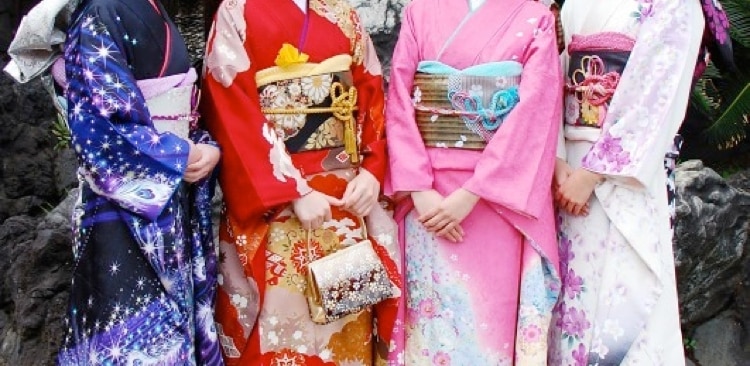5 Differences Between Kimono and Yukata You Probably Did Not Know

We all know about Kimono, a famous traditional dress of the Japanese which has inspired international fashion in many ways. However, there is a traditional Japanese dress, Yukata, which you might not know and which resembles Kimono, but is not entirely the same thing.
When you look at both of them, you would very easily notice that they full-bodied, T-shaped robes featuring the quintessential long sleeves and an ornate belt. But, I will tell you that there is a world of subtle differences between these two dresses in this article.
But, before I tell you those differences (which are 5 in number), let me remind of you of one fundamental rule regarding both Kimono and Yukata—remember that left panel is worn over the right; the other way around is considered rude because that styling is used when the dead are dressed up before funeral.
With the rule on the mind, let us find out what makes these two seemingly alike garments different:
Kimono and Yukata: The fabric of the garments
The fabric used in Kimono is far more superior to that used in Yukata as a consequence of which the former is more expensive. The material used in Kimono is generally silk or brocade. On the other side, Yukata served the purpose of bathing robes and were traditionally worn by nobles. Due to this, the material used in making them is generally cotton because of which they are usually worn during summers, as they tend to keep bodies cool and well-aerated.
Let me be honest with you: Kimonos can be really hard on your pockets, even when you purchase second-hand kimonos. Yukata, however, can be purchased much more conveniently, and I suggest that you get one while you are here in Japan.
Kimono and Yukata: Occasion
Considering the differing purposes of these two garments, these two are worn on different occasions.
Yukata is generally worn during summers, especially when attending festivals or fireworks. So, you can expect Yukata to be brightly
Kimonos are far more conventional than Yukatas, making them fit for formal occasions such as graduation or wedding ceremonies.
Though there are traditional rules regarding when these two garments must be worn, people have started wearing them irrespective of occasions. Just go out on streets and you will most likely come across people wearing either of these two garments!
Kimono and Yukata: The Shape of these dresses
There are two basic shape-related differences between Yukata and Kimono: the first one concerns the length of their sleeves and the second concerns the collar,
The length of their sleeves is a major identifying factor for distinguishing between these two garments. In Kimonos, the length of the sleeves depends on a range of factors such as marital status and age. For example, married women have their kimono sleeves short whereas unmarried women have their Kimono sleeves running long enough to touch the ground. In Yukata, however, the length of the sleeves is strictly limited to 50 cm and should not touch the floor.
The second difference is that of the collar. The collar of a Kimono is softer and broader than that of Yukata. The softness is attributable to the material used in Kimono, which is either silk or brocade (as noted above!).
Kimono and Yukata: Styles Available
If you want to buy a Kimono, you will get a huge range of styles to choose from, especially for women. These styles include Komon, Furisode, Iromuji, and Homongi. Also, every Kimono is worn along with a lining which is worn underneath. In the case of Yukata, there is no such lining worn, and its styles are simpler.
Kimono and Yukata: Seasons Most Appropriate
It must have become already clear when you should be wearing these two garments, but let me clarify on this again.
As written before, Yukatas are made of lighter material which keeps the body cool and hence, it is best to wear them during summers. In the case of Kimono, there are extra layers worn which add to the weight of the garment, as a consequence of which it is recommended that it should be worn in winters. But, this does not mean that you cannot wear Kimonos during summers at all. You can actually, as there are lighter alternatives available.
Have you read?
# Best Countries For Business In Europe For Non-European Investors, 2019 . (Europe)
# World’s Top 100 Cities To Reside In For 2019.
# World’s Best Countries To Invest In Or Do Business For 2018.
# RANKED: The World’s Top 10 Richest Countries (2017-2027).
Add CEOWORLD magazine to your Google News feed.
Follow CEOWORLD magazine headlines on: Google News, LinkedIn, Twitter, and Facebook.
This report/news/ranking/statistics has been prepared only for general guidance on matters of interest and does not constitute professional advice. You should not act upon the information contained in this publication without obtaining specific professional advice. No representation or warranty (express or implied) is given as to the accuracy or completeness of the information contained in this publication, and, to the extent permitted by law, CEOWORLD magazine does not accept or assume any liability, responsibility or duty of care for any consequences of you or anyone else acting, or refraining to act, in reliance on the information contained in this publication or for any decision based on it.
Copyright 2024 The CEOWORLD magazine. All rights reserved. This material (and any extract from it) must not be copied, redistributed or placed on any website, without CEOWORLD magazine' prior written consent. For media queries, please contact: info@ceoworld.biz
SUBSCRIBE NEWSLETTER








